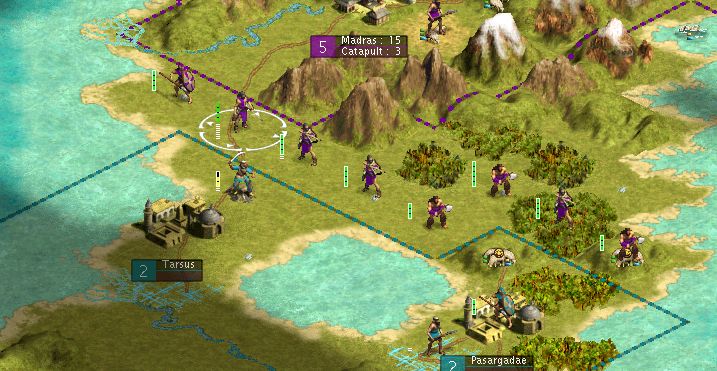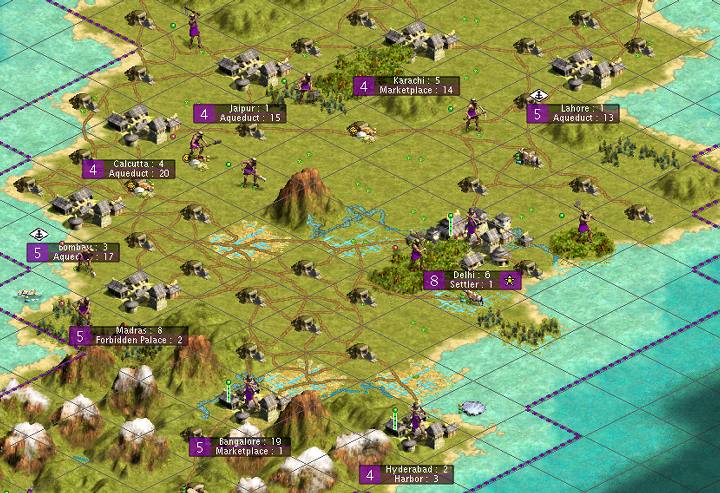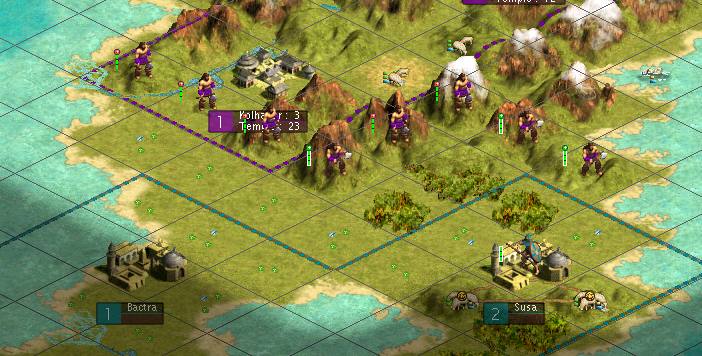1.27
I want to echo what others have said - well done Ainwood! This is an interesting and fun game, thanks!
I started a bit late due to RL pressures this month. For the same reason I decided my goal would be domination.
Opening Moves
As I planned pregame I moved the worker to the mountain first, and when he saw nothing moved the settler E. That of course brought the cattle into view. Once again our seers-under-the-fog have amazed me with their accuracy!

I settled E of the start position. Delhi built warrior, warrior, granary (2950BC), worker, settler (2670BC), settler (2510BC.)
All worker efforts were focused on quickly making Delhi into a four turn warrior+settler factory. After producing the second settler in 2510BC it was at size 4.5 and ready to run. The first cycle began, producing a warrior in 2470, a settler in 2350, and so on.
Build Pattern
By the time Delhi built its first settler my warriors had explored most of the home region and it was clear that things were going to be tight. After mulling it over for a long time I chose to go for a ring 5 build. Yup, a crazy one

The one large drawback to a ring 5 build was that I'd have a number of good tiles near Delhi which would not get worked by any city at all. (Unless Delhi passed size 12 eventually, which I did not expect

) But I liked the city sites available in ring 5 more than those in rings 3 and 4, and I'd be able to get more productive cities than in the closer rings.
Ring 5 grew to have eight highly productive cities. Here's how they looked at my cutoff date for this thread, 570BC:
Most of my cities could produce 2 shields/turn from the moment they were settled. Since I urgently wanted workers, and since each city could produce 20 shields before reaching size two, I had most of the cities begin by producing a warrior and then a worker.
Between Delhi pumping a warrior every four turns and many other cities slipping one in before their first growth, I ended up with a lot of warriors. I didn't have any particular plan for them, they just seemed a good thing to do with the excess shields.
Barbarians
It is a long time since I've had so much early barbarian activity. Partly this was because there was no AI helping to suppress them of course. But I wonder if there was another factor at work. Perhaps that other parts of the world became filled more quickly? (And therefore that when a barb camp was to be placed somewhere, the game often decided to put it near us?) I lost a few warriors to barbarians and had a couple of close calls. But I had a lot of warriors to spare and it wasn't a big problem.
The barbarian camps were helpful. I was constantly short of money in the early game. I wanted to research as fast as I could and didn't have neighbors who could help with finances. In fact I was paying Persia for tech for a while. The barb camps made up the difference. Once I'd settled most of the start area and explored it all, I harvested a couple of extra barb camps in the tundra by moving warriors in and out before finally settling there.
Research
I begain by researching Pottery at maximum speed. Learned it in 3200BC and began on Writing at max.
I held off trading tech with Persia at first. I was hoping to find another Civ or two first so that trade prices would go down. That didn't happen of course. In 2350 Persia started researching a tech I had so I decided to start trading, getting The Wheel and Bronze Working from her. Darn, no horses in sight.
Persia beat me to Writing by one turn. I learned it in 1870 and started on Map Making. I should've known better, Persia beat me to that too. When she learned it in 1500 I bought it from her.
So I'd duplicated research with Persia twice. With Writing I thought I had a good chance to get it first because it wouldn't be valued as highly as usual. (Because it does not enable trading of contacts.) And with Map Making I used the same reasoning plus figured I couldn't afford a risk - if neither Persia nor I went for it, I wouldn't be visiting other lands any time soon. Oh well, at least I was able to buy Map Making at a good price since I'd invested a fair bit in researching it.
After trading for Map Making (and of course immediately starting to send out galleys whose adventures will be described in another spoiler) I went straight for Republic as quickly as I could. Learned Philosophy in 1325 and traded for CodeOfLaws in 1275.
In 1150BC I traded with civ#1 for Mysticism, Iron Working, Warrior Code, and Masonry. And in 850BC traded with civ#2 for Horseback Riding.
Learned Republic in 800BC and immediately flipped to it. I've stayed in Republic since then.
Traded with civ#2 to get Mathematics in 800BC.
Learned Currency in 690BC, and learned Construction in 570BC to enter the Middle Ages at that time.
Conflict With Persia
In 1475BC I had a difficult decision. Persia tried to extort 5g. A measly 5g. I normally wouldn't hesitate for a moment to pay. One little problem this time though. All I had in my treasury was 5g. And I was running a negative income. So if I gave in to Persia I'd lose something. And the only thing I had available to lose was the granary in my settler factory. Not a pleasant prospect

By that date I'd secured the north from barbarians except where I was deliberately farming them, I had what MPs I wanted, and I nonetheless had a number of spare warriors. I'd been sending those spares to block Persians from coming north to explore. As a result my southern border looked like this in 1475:
Though I had no spearmen nor archers, and I hadn't planned on war yet, warriors fortified on mountains seemed likely to be a good barrier. So I refused the extortion rather than lose my granary.
And Persia declared war.
This war was worrisome but worked out fine. I didn't try to make any gains. I just wanted to hold the border until I could end the war without losing anything and without diverting much effort from my planned development. I sent a number of additional warriors south for support (each warrior in the image above is a single unit - they weren't in the area for strength, just for blocking.) But I didn't divert any build efforts to support the war.
Persia lost a few archers and I lost a couple of warriors. Persia also sent one immortal north who killed just one of my warriors before I was able to negotiate peace. (At a slight profit

) And that was it for the first war. At its end Persia had just started her Golden Age and that suited me fine - that was as good a time as I could ask for her GA.
In 1150BC, a bit after the end of the war, I learned Iron Working and saw just what we were in for. (The word I used in my notes was "diabolical" when I saw that single source of iron.) The pile of warriors I had (16 surviving after losses to barbarians and Persia) were going to be useless unless I could wrestle the only iron on our continent away from Persia.
And there seemed little point in going for the iron, which was under Arbela as in most games reported so far. Even with a direct strike using galleys I'd need a bunch of archers to do it and I had none yet. Persian forces built in the meantime during her GA would be strong and my losses would be high. I decided to research toward Elephants as quickly as possible before dealing with Persia.
And so I had no further conflict with Persia in Ancient Times.
QSC
My status at 1000BC:
13 towns
3 barracks
2 temples
1 granary
12 native workers
16 warriors
1 spearman
4 galleys
187g in treasury
Miscellaneous
I popped one goody hut and it gave me maps of the area.
I tried to build the Great Lighthouse but didn't prioritize it heavily and it turned out I'd started too late. A Civ named Carthage (somewhere out there

) built it. I switched my wonder build to Palace for a while. But I didn't see a wonder I wanted being available soon and subsequently switched the build to a Forbidden Palace. It wasn't in a great location for FP (was on the coast west of the Palace) but it nonetheless helped my empire's growth and I think paid back the shields invested fairly quickly.
Assisted by her Golden Age, Persia built the Pyramids in 1200BC. Nice, another reason to plan her demise!
![PTW Icon [ptw] [ptw]](/images/smilies/ptw.gif) 1.27f Open
1.27f Open


 . Around 400 BC Civ X sailed into view having build the Lighthouse. It was apparent that Persia had seen them first, as they had a couple of new techs all of a sudden a few years before. So both civs had the same tech set, giving no room for brokerage, and all it did for me was to reduce prices a bit.
. Around 400 BC Civ X sailed into view having build the Lighthouse. It was apparent that Persia had seen them first, as they had a couple of new techs all of a sudden a few years before. So both civs had the same tech set, giving no room for brokerage, and all it did for me was to reduce prices a bit.
 AlanH!
AlanH!
![Civ3 Icon [civ3] [civ3]](/images/smilies/civ3.gif) Open
Open . To top this, Persia has not got Pottery so I need to research by myself at full speed it is a mere 6 turns but still. Then I can go on searching MM
. To top this, Persia has not got Pottery so I need to research by myself at full speed it is a mere 6 turns but still. Then I can go on searching MM
 on my part to not have done it earlier.
on my part to not have done it earlier.


